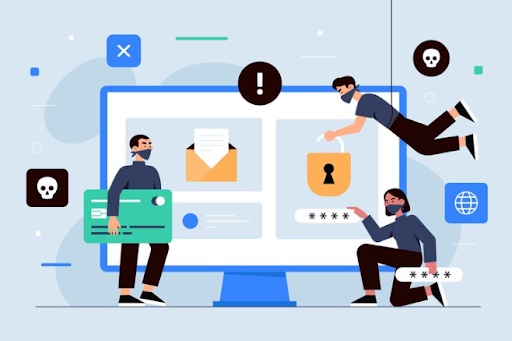Phishing attacks have become a ubiquitous threat in our digital lives, targeting both individuals and industries with deceptive tactics to steal sensitive information. While most of us have heard of phishing, the subtlety and sophistication of these cyber threats continue to evolve, making it increasingly important to stay informed about the latest tactics. This blog post will expose six common phishing attacks and equip our readers with the knowledge they need to stay safe in the digital sea.
1. Deceptive Phishing Via Spoofed Emails
Spoofed emails masquerade as communications from familiar or trusted sources, like a colleague or a reputed company, often with alarming content to rush the recipient into taking action without thinking. The link in the email isn't what it seems and can lead to a fraudulent website that steals your data. A classic example is an email that appears to be from your bank, warning of account suspension if you don't log in promptly.
Real-World Example:
A healthcare professional receives emails that appear to be from the IT department, asking them to enter their login credentials on a supposed new security platform. The email is a phishing attempt; the website the link leads to is a fake domain designed to mimic the login page of their hospital management system.
2. Fake Login Pages: The Bait of Credential Harvesting
This type of phishing attack often piggybacks off of Spoofed Emails. It lures users into fake login pages that imitate the real ones from trusted services. The aim is simple but devastatingly effective: harvest user credentials by capturing them as soon as they are entered.
Real-World Example:
A dental clinic employee receives an email informing them of new software updates. The email includes a link to a fake Microsoft 365 login page, where the employee unwittingly gives away their network credentials.
3. The Menace of Voice Phishing (Vishing)
Vishing occurs when attackers use a phone call to trick victims into providing sensitive information, often by posing as a legitimate organization, such as a bank or government agency.
Real-World Example:
A series of calls claiming to be from a national health service requests personal identification numbers (PINs) from individuals, citing the need to verify insurance coverage after a recent data breach. Unfortunately, many individuals unknowingly gave away these critical security details.
4. Spear Phishing Attacks on Executives
Spear Phishing is a more targeted form of phishing that focuses on specific individuals or organizations, often using information gleaned from social media or official company publications to customize the attack and increase the appearance of legitimacy.
Real-World Example:
A C-level executive in a healthcare company is sent an email seemingly from a government health department, requesting a large file containing patient data for a compliance audit. The request seemed urgent and legitimate, leading to a significant data breach when the file was emailed back to the supposed agency.
5. Pharming Attacks and Exploiting DNS
Pharming is more insidious, as it doesn't rely on users clicking on a malicious link. Instead, it redirects users to fraudulent websites without their knowledge by manipulating the Domain Name System (DNS).
Real-World Example:
A neurosurgeon's office network was infected with malware that altered the DNS settings, redirecting all traffic to a supposed health insurance provider's website to a fake login page designed to capture user credentials. Because the redirection was automatic, it was harder to detect unless the user had been to the insurer’s login page recently and noticed the discrepancies.
6. LoJack and HTML 5 Phishing
LoJack and HTML 5 Phishing are more advanced tactics that use special software or the HTML 5 standard to make phishing sites more resilient and harder to detect.
Real-World Example:
A diabetes clinic's appointment reminder software was compromised by adding a fraudulent HTML 5 overlay that mimicked the real appointment reminder system. Patients who clicked on the email link to confirm their appointments ended up on a phishing page, which captured their credentials when they attempted to log in.
Identifying and Avoiding Phishing Attempts
To evade these perilous tricks, it’s crucial to approach all unsolicited or unexpected communications with a healthy dose of skepticism.
Email and Website Red Flags
- Look for grammatical errors or unusual phrasing—a telltale sign of a phishing attempt.
- Check the sender's email address for slight variations from the official one.
- Hover over links to reveal the true URL, and ensure it matches the brand's official domain.
Verifying Sender Legitimacy
- If an email seems odd, call the supposed sender using a number from their official website or directory.
- Confirm any unexpected requests with colleagues or superiors, especially those regarding sensitive data or money.
Staying Updated on Security Protocol
- Ensure all security protocols are up-to-date and active, from firewalls to email filters.
- Invest in training staff about the latest phishing techniques and how to avoid them.
What to Do If You Fall Victim to Phishing
If you suspect you’ve fallen for a phishing attempt, time is of the essence. Act quickly to minimize damage and prevent further compromise.
Immediate Action Steps:
- Disconnect from the internet and your network to contain the damage.
- Change passwords for all potentially affected accounts.
- Contact your IT department or a cybersecurity professional for further assistance.
Conclusion
Cybersecurity is an ongoing battle, with phishing attacks continually evolving. Staying informed is the first and most effective line of defense. We've uncovered six sneaky phishing types in this post, but these are just the beginning. It's vital to remain vigilant, continuously educate yourself and others, and always be cautious in our interconnected world. By being aware of the threats that lurk in our digital channels, you can help ensure you don't fall victim to the bait.
Remember, knowledge is power, and in the case of phishing attacks, it's the power to protect not only your information but also the integrity of your professional and personal reputation. Spread awareness, share what you've learned here, and together, we can outsmart the phishers and safeguard our virtual existence.
For additional reading on enhancing your online security practices, the National Cyber Security Centre (NCSC) and other local authorities provide a wealth of resources and guidelines. Take the time to review and implement their best practices, and stay safe out there in the digital ocean.


No comments yet